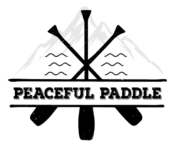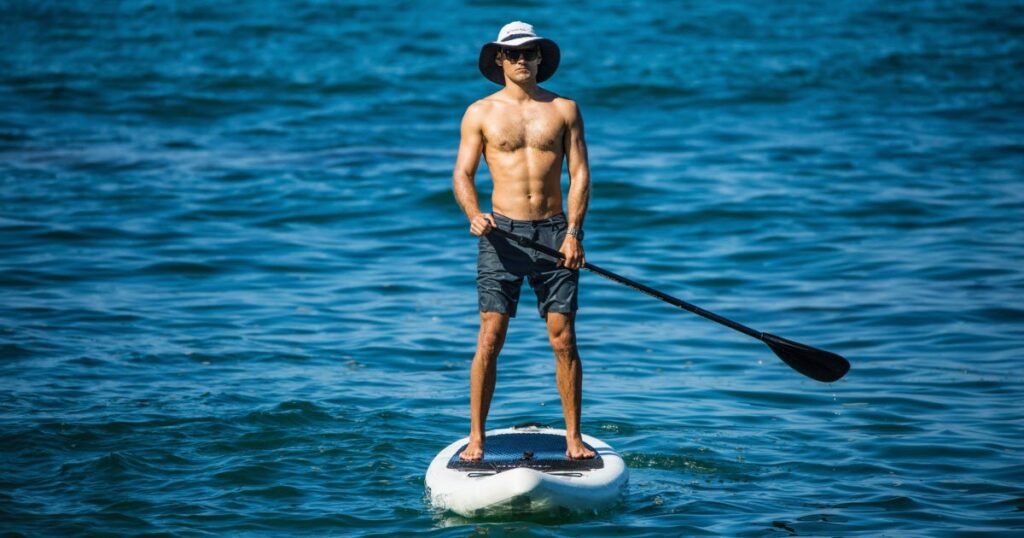Stand-up paddle boarding is an excellent full-body workout. For such a relaxing activity, it’s a surprisingly great calorie-burner and offers meaningful health benefits. You’ll need to be competent on the board if you want an optimal workout, though. That takes time and practice. Let’s learn more about the calories burned paddle boarding, and how you can calculate the calories you burn in any given outing on your SUP.
Of course, people paddle board for all types of reasons, and the satisfaction and enjoyment you’ll get from paddle boarding make the workout and the type you take learning proper technique worthwhile. Once confident on the board, you’ll work your core, back, arms, and legs. It’s a full-body workout!

Of course, this means a big calorie burn. For such a relaxing activity, paddle boarding is a surprisingly great calorie-burner and offers meaningful health benefits.
Getting a Sense of the Calories Burned Paddle Boarding
A 176 pound individual will burn around 504 calories per hour paddle boarding when engaging in moderate effort. That same individual can burn up to 840 calories per hour while performing high-intensity paddling. That said, there are a number of factors (such as your paddling technique, the weather and water conditions, and your equipment) which can impact how many calories you will burn paddle boarding.
Let’s explore these factors which influence how many calories paddle boarding burns, as well as the best techniques to get the most out of your workout!
I’ll also share a formula you can use to do a custom calculation for a person of your size and body type.
Proper Technique Boosts Calories Burned Paddle Boarding
Experienced paddle boarders burn a lot of calories, but if you’re a complete novice and unable to maintain your balance on the board, you won’t burn nearly as many.
However, if you invest enough time to honing your technique, you’ll soon gain noticeable muscle tone.
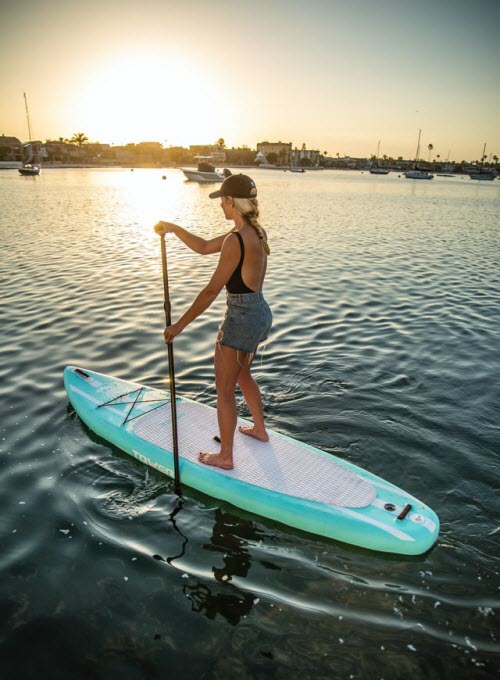
Check out my article on the challenges of paddle boarding for advice on how to get started.
The American Council on Exercise carried out two studies on paddle boarding to assess the fitness benefits.
The first study investigated which muscle groups paddle boarding works. It found that while moderate paddling engage the lower back and front abdominal muscles, the most striking muscle gains take place in the obliques. This is because twisting is an essential motion repeated throughout the exercise. As a beginner, you won’t have this twisting motion down.
The second study focused on the cardiovascular aspect of paddling, and how much it can increase heart rate. For its research, the ACE team divided beginner paddlers into two groups. The first group used a paddle machine, while the other group used a real paddle on the water.
The results showed that beginners can obtain cardio benefits from an artificial paddling machine, but not from real-life paddling. This is because of their lack of experience. They couldn’t balance and maneuver themselves effectively. This made it difficult to get enough exercise to raise their heart rates.
It’s clear that mastering paddle boarding technique is essential if you want to burn calories and gain muscle from this activity.
So, How Many Calories Can You Burn Paddle Boarding?
If you’re an experienced paddler, you can expect to burn some serious calories while paddle boarding.
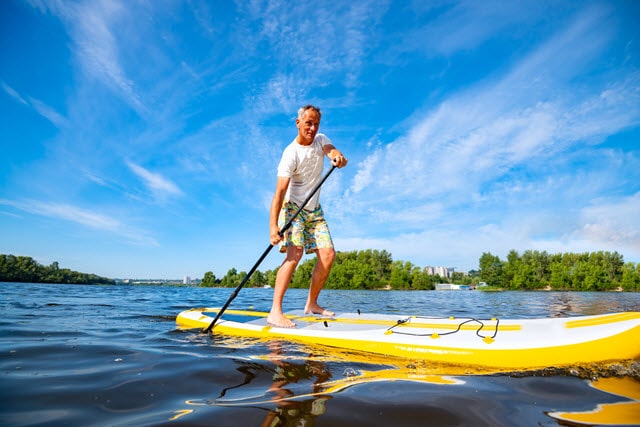
For all types of exercise, a certain formula can be used to calculate the number of calories burned. We’ll use it below for paddle boarding.
Calories burned per minute paddle boarding = (MET x body weight in Kg x 3.5) ÷ 200
if you prefer pounds to kilograms, use the following formula:
Calories burned per minute paddle boarding = (MET x (body weight in pounds ÷ 2.205) x 3.5) ÷ 200
“MET” (Metabolic Equivalent) is a rating system referring to how much energy is required to perform a certain physical activity.
A MET of 1 equates to very low levels of activity, like sitting still just watching TV. Walking at a moderate pace is equivalent to a MET level of 3. Higher levels of exertion begin at a MET level of 4.
An intermediate paddle boarder’s exertion level will equal a MET level 6. Vigorous, racing paddling can go as high as level 10.
Therefore, an 80kg or 176lb person can expect to burn the following number of calories per minute of paddle boarding:
Moderate effort: (6x80x3.5) ÷ 200 = 8.4
High-intensity paddling: (10x80x3.5) ÷ 200 = 14
This 80kg or 176lb individual will burn around 504 calories per hour when engaging in moderate effort. That same individual can burn up to 840 calories per hour while performing high-intensity paddling.
However, these numbers are just a guideline. It’s natural that the momentum and engagement of stand-up paddling will vary, as paddlers take breaks, slow down, and speed up at various points. These factors affect the number of calories burned.
In addition, MET values don’t take into account a variety of factors that can affect the number of calories burned, such as differences in muscle mass, age, sex, and geographic environment.
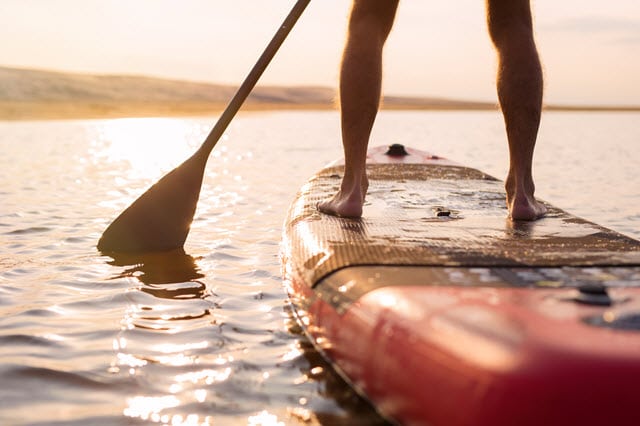
However, if you’d like a rough estimate based on your body weight and effort level based on the formulas described above, you can use this Paddle Boarding Calorie Calculator to get a rough estimate of how many calories you’ll burn on a SUP:
Paddle Boarding Calorie Calculator
Which Muscles Does Paddle Boarding Exercise?
Paddle boarding is particularly good for the abdominal muscles, and of course, works the back and arms too. Correct paddling technique is important for achieving those benefits.
During moderate paddling, both your abs and your back muscles are sufficiently engaged to cause muscle strengthening over time. Increasing the intensity of your paddle strokes will help optimize this.
While stand-up paddle boarding is a full-body immersive sport, the external abdominal obliques will engage the most.
Top Tips for a Better Workout
As a general rule, you get out of paddle boarding as much as you put into it. It can be a great full-body workout, causing you to gain significant muscle. You need to put in a lot of effort while attending to your form and posture. Here are some tips for achieving the best result.
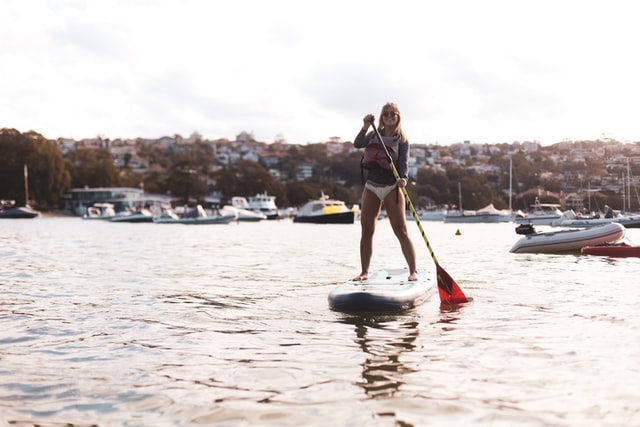
Use Proper Form and Technique
Summon your strength directly from the core. Don’t over-rely on your arms. Bend the knees slightly to help with balance and keep your eyes forwards. Try to engage your back muscles. Remember, proper form will use all your muscles without relying on just one group.
While paddling, twist your core and turn your shoulders with intention and force. You want to achieve a long, powerful stroke. This will get you moving faster, engaging your core and obliques. And you’ll burn more calories.
Increase Your Driving Power
Stand-up paddle boarding is as dynamic or relaxed as you make it. Exert as much power as you feel you can, and build up momentum. When you use proper form, you get the most power while out on the water. That lets you build speed and intensity while enjoying a more intense workout.
If you want to optimize calorie burn from paddle boarding, go into it with a workout mentality.
Optimize Your Nutrition
Consume protein before or after you’ve been on the water. Pack some nutritious snacks in case you need an energy boost.
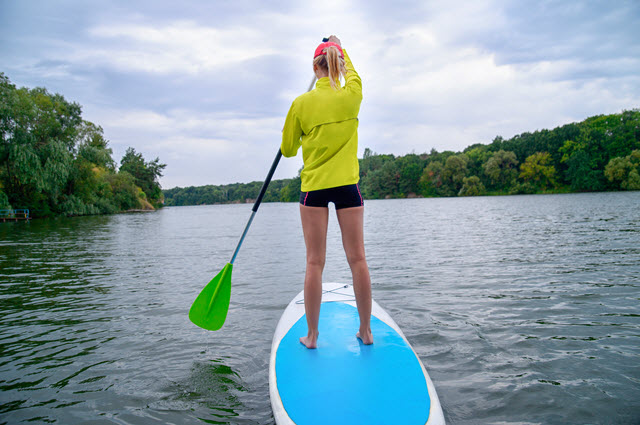
You don’t want to feel weak while out on the water, and nutrition gives your body the necessary energy to paddle board effectively. Make sure you eat protein and carbs to feed your muscles to recover quickly when off the water.
The right nutrition is essential if you want the energy for calorie burning!
Do Your Stretches
Remember to stretch before and after paddling to aid muscle recovery and promote flexibility. This keeps your muscles loose and prevents you from being as sore the next day.
Shoulder, ab, back, and leg stretches are especifically helpful for recovery. And that means you can get back out on the water sooner, burning more calories!
Quick Tips for Improving Paddling
- Always keep the knees slightly bent.
- Keep your back straight and your eyes directly ahead of you (don’t look down).
- Apply long strokes and plunge the paddle deep into the water.
- Place the paddle in the water vertically.
- Keep your hands one on top of the other on the paddle.
- Keep your hips firm and unmoving; twist up from the hips.
- The bottom arm should always stay in a fixed position.

You Can Combine Yoga With Paddle Boarding
It’s more popular than ever to combine yoga and paddle boarding. Yoga builds core strength and helps with balance, which improves your paddling overall. When you paddle better, you burn more calories.
And it’s good for your general well-being and mental health. Being on the water during yoga creates a feeling of harmony.
All in all, yoga combined with paddle boarding is a great way to spend more time on your board while improving your paddling technique!
Paddle Boarding’s Wide-Ranging Health Benefits
Beyond burning calories and building muscle, paddle boarding offers several great health benefits.

- Exercise releases endorphins that alleviate stress, while relaxing waters have a complementary calming effect.
- Spending time in nature is a proven way to improve mental health and lift low moods.
- Your balance and posture will both improve as you become competent on the board. You’ll become more agile and athletic in everyday life.
- Your stamina and endurance levels will increase, which will prove useful when embarking on any other sport or physical activity.
- It’s a great way to bond and spend time with others. Doing activities together in the outdoors works wonders for building relationships.
Overall, stand-up paddle boarding is an excellent way to burn calories, build muscle and improve your mental and physical health.
So, what are you waiting for? Go grab a paddle board and get started!
